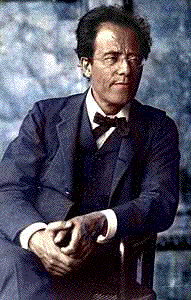
Here are Program notes for the Mahler for the May 7th concert by orchestra percussionist and Symphony Board president Bob Whalen.
Mahler was recognized as an extraordinary talent at the piano upon entering the Vienna Conservatory when he was fifteen. He was given influential positions as a conductor in his adult life, and gained the support of fellow composers, including Arnold Schönberg, who proclaimed Mahler a saint. Yet his symphonies rarely won wide favor with critics or audiences until well after his death – first, with Bruno Walter and Dmitri Mitropoulos, and later with Leonard Bernstein. Today, Mahler’s symphonies are staples in the orchestral repertoire and are heard in performance all over the world.
A trademark of Mahler's symphonic style is the use of quotation, mostly of Mahler's own songs. Yet none of his ten (or eleven, if you count Das Lied von der Erde) relies on quotation as much as his First Symphony. The “Titan,” as Mahler’s First Symphony is popularly known, opened to cool audiences and disparaging critics on November 20th, 1889 as a five-movement symphonic poem. The attacks from critics came in large part in response to his revolutionary orchestrations. The concept of using a “vulgar town band” playing klezmer-style music in turn-of-the-century Berlin drew many appalled reviews, souring what might otherwise have been a triumphant premiere.
Lost on the audience accustomed to Romantic extroversion were the ironies pervading the work, resulting from the use of pervasive quotation. His quotations begin in the first movement of the First Symphony, drawing from his song cycle Lieder eines fahrenden Gessellen (Songs of a Wayfarer). Another song from his Lieder und Gesänge provides the basis for the second movement. Originally titled Maitanz im Grünen, the second movement owes a substantial amount to Hans und Grethe.
The third movement, infamous at its time for the parody of “Brüder Martin” (Frère Jacques) and for the use of klezmer-style interpolations with the instruction to play Mit Parodie (Parodically), is yet another field in which Mahler sows tunes from Lieder eines fahrenden Gesellen. In this movement, Mahler quotes material from the final song from his cycle, Die zwei blauen Augen von meinem Schatz.
The final case of Mahler’s self-quotation in the First Symphony is from his song, Hochzeitsstück. However, he also references, And He Shall Reign Forever and Ever from the Hallelujah Chorus of Handel's Messiah. The Messiah quotation, though not taken from Mahler's own output, is significant because it is a major-mode version of the minor descending melodic fourths statement in the woodwinds that begins the symphony, lending a cyclical structural unity to the work.
No comments:
Post a Comment